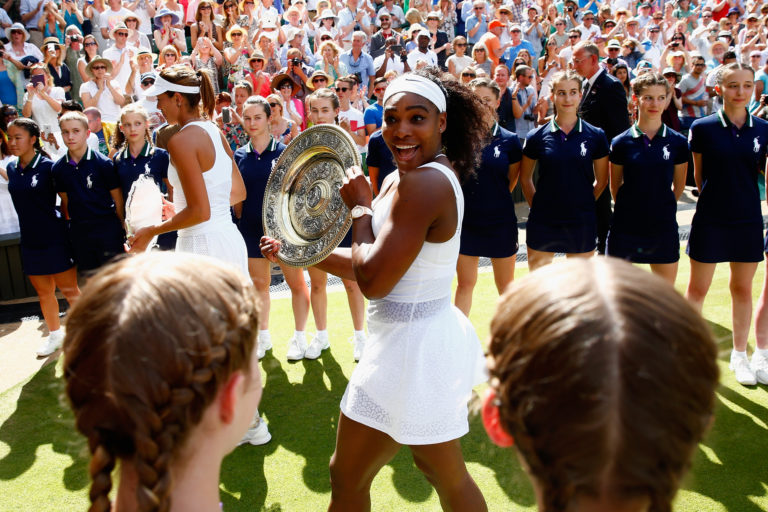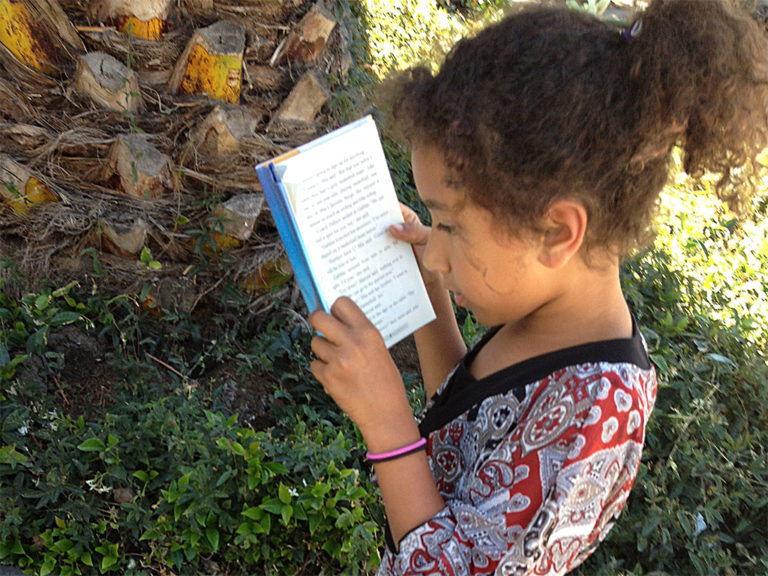
Serena Williams leaves the court with the Venus Rosewater Dish after her victory in the Wimbledon final over Garbine Muguruza of Spain. Image by Julian Finney/Getty Images.
Acknowledging the Gifts and Talents of Women
The last two weekends have offered plentiful chances for me to spend time with my two beautiful daughters watching talented women excel in the most public of settings. Two weekends ago, it was the U.S. women team winning the World Cup in dominating fashion. This past weekend, it was Serena Williams cementing her position as the most dominant solo female athlete of her generation. Being both a sports fan and also someone who adores the realm of the spirit, all of this has me thinking about women and spiritual leadership.
Watching the U.S. women win the World Cup, and then the Serena Williams victory, I watched my daughters’ faces closely. It hit me that they so rarely get to see women’s excellence being celebrated on TV in such a communal fashion. Women’s sports are usually 5 percent (or less) of sports broadcast on American television.
While my daughters often talk about being astronauts, ballet dancers, moms, writers, poets, presidents, princesses, singers, doctors (basically, anything their hearts dream of), this past two weeks they were talking about playing tennis at Wimbledon.
It is also a reminder of the fragmented nature of justice and progress. Yes, these are important accomplishments for women, but the specter of race (and class) continues to haunt us. Soccer (football to the rest of the planet) is the ultimate global game, as Latin American and African as it is European and American. And yet watching the Women’s World Cup, and celebrating this extraordinary accomplishment, I couldn’t help but wonder where the girls are whose skin looks more like the lovely mocha-color of my daughters. Where are the Hispanic women? Where are the African-American women? The U.S. Women’s team, for all of its extraordinary accomplishment, is still a profile in whiteness.

Race also continues to haunt us when it comes to Serena Williams. She is not merely the most successful female tennis player of her generation. Her celebration is never far from an elite (and overwhelmingly white) sport’s anxiety over her blackness. No less than the New York Times has dwelled on her body, quoting her rival’s coach as stating that other players are smaller than Serena because “first of all she’s a woman, and she wants to be a woman.” As if Serena, this masterful and dominating athlete, is somehow not a woman, somehow less of a woman.
To somehow see this obsession with Serena’s body, with her biceps and behind as not being connected to decades of obsession with black women’s bodies, is of course naïve. The Times piece goes on to say, “Her rivals could try to emulate her physique, but most of them choose not to.” The title of the piece? “Tennis’s Top Women Balance Body Image With Ambition.”
When was the last time that the New York Times published a piece discussing the male players’ body image? Yeah, we can’t remember that either. It doesn’t seem to matter whether Serena ignores the obsession with her body, or deals with it with grace and humor. It doesn’t seem to go away.
I have no delusions about being a “post-racial” society or a “color-blind” society. I do expect us to acknowledge the tensions and shortcomings, and work to address them structurally.
It’s hard to not see the difference in ideals of beauty, white vs. black, as having a concrete material consequence. The starkest contrast is between Serena Williams and Maria Sharapova. For more than a decade, Sharapova has been the highest gross paid female athlete in her sport, even though her career accomplishments pale in comparison next to Serena’s.
In fact, in their last 20 meetings, Serena Williams has an 18-2 recent record against Sharapova; Serena Williams has won 21 single grand slam titles, compared to Maria Sharapova’s 5. Yet it is Maria Sharapova, frequently described as a stunning blonde beauty (words like “Barbie” are used entirely too frequently in tennis blogs), who earns on average twice as much as Serena Williams. Should it be a surprise that the same New York Times writer compares Sharapova’s size to a “Barbie doll”?
It got so absurd that even J.K. Rowling had to step in to defend Serena against absurd accusations that she “looks like a man.” And she did so in a brilliant fierce tweet.
.@diegtristan8 “she is built like a man”. Yeah, my husband looks just like this in a dress. You’re an idiot. pic.twitter.com/BCvT10MYkI
— J.K. Rowling (@jk_rowling) July 11, 2015
All this dwelling on the Women’s World Cup and Serena Williams, thinking about how far we have come and yet how much more we have to go, has me thinking also about religious and spiritual leadership. I’m thinking of my own Muslim community. In a way we have never had more prominent Muslim women whose scholarly, artistic, intellectual, and civic leadership is so easily accessible and visible for all to learn from.
Looking forward to @Al_Rawiya‘s ShaykhaFest 2015 which will feature inspiring roster to #NextTimeRememberHer pic.twitter.com/eYVJl69oST
— M. Hasna M. (@MHasnaM) July 12, 2015
Whether it is the scholarship of a Kecia Ali, Sa‘diyya Shaikh, Amina Wadud, Ingrid Mattson, Jerusha Tanner Lamptey; whether the fiction of a G. Willow Wilson and Elif Shafak; whether the social/spiritual commentary of Samar Kaukab, Hind Makki, Maria Ebrahimji, Jamillah Karim, Linda Sarsour, Dalia Mogahed and Rabia Chaudry, Muslim women have perhaps never been more prominently known. And yet…
When it comes to institutional formats, we are still not much beyond the realm of sports, with its 5 percent focus allotted to women. We still see entire panels of male scholars, male institutions, and models of authority lifted up as the standard that systematically marginalize and exclude women. A recent social media campaign, called #NextTimeRememberHer was designed to shine a light on precisely such a painfully excluding and marginalizing reality.
As hard as women scholars study it’s never enough. What about @IngridMattson on this panel? #NextTimeRememberHer pic.twitter.com/itg9WcOJaL
— Linda Sarsour (@lsarsour) July 12, 2015
How absurd that we have talented Muslim women writing Friday sermons but be excluded from actually delivering them because their voice is going to be considered awrah, sexually tantalizing and scandalous to male audiences.
How absurd that universities create positions for Muslim chaplains, but remain unsure of whether they can hire Muslim women because women would not be allowed to lead congregations of men and women in prayer.
How absurd that now, in 2015, we would even need a campaign to encourage popular online resources to include the recitations of women among their Qur’an collection.
How absurd, how sad. And yet, here is where we are.
If we aspire for a better today, better tomorrow, we have no choice other than staring our reality fully, and shine the light of justice on an injustice that we ourselves are complicit in creating and maintaining.
Is there any other realm in life that I would have to look at my daughters, my beautiful bold talented daughters, and tell them that they are not qualified because they are girls? And then to tell them to find meaning, truth, and beauty in these very realms that ultimately exclude them? And how to look at my sons, and tell them that they are the beneficiaries of unearned privilege in the very realm of life that purports to bring them to God?
I am not naïve abut the imperfect society that we inhabit, and in fact create. The lines of class, race, sexism, homophobia, anti-Semitism, Islamophobia, and ableism are with us. Somehow it hurts more deeply when it occurs in the name of religious and spiritual institutions. Ultimately, I expect religion to uplift, transform, and deliver us to God. When we fail to do so, it is somehow extra-brutal.
May we be participants in creating a society in which all of our children can follow all of their dreams: physically, intellectually, emotionally, and spiritually. May our society be one that benefits from the gifts and talents of all of us.
I say this not out of a lack of love for my tradition or my community. Far from it. It’s because I love my daughters — and my sons — enough to want to struggle for a tradition and community in which all of our gifts and talents can be acknowledged.
We can only transform a tradition that we love. I love my own tradition enough to be disappointed in this aspect of it, to want to struggle to make it better.
A society that relies on the talents of half of its dreams is only half a society. May we be whole-hearted, a whole society, a healed society, one that acknowledge the immense gifts of all of us, men and women, boys and girls.


Share your reflection